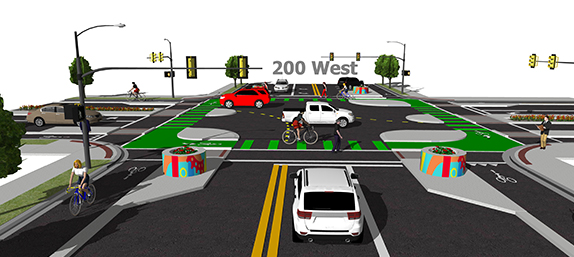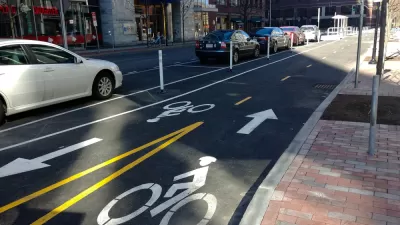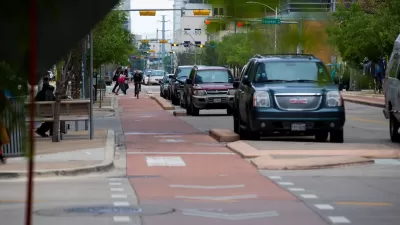The first protected intersection opened in August in Davis, Calif., a university town with the nation's highest percentage of bike commuters. Salt Lake City's new protected intersection is explained on NPR's "Here & Now" report with audio and videos.
Here & Now’s Robin Young gives an excellent introduction to protected bike lanes and the protected bike intersection, mentioning the rise in bike fatalities and recent controversies:
- "In 2013, there 743 bicycle fatalities across the country," and the controversy in some bike lanes, including
- the recent removal of a small stretch of protected bike lanes in Boulder, Colo.
"'Protected intersections,' designed to prevent car-bicycle collisions, have long existed in the Netherlands, but they are just catching on in the U.S.," states Young. She credits "a young, former video designer named Nick Falbo (who) made a video that urban planners understood" for the recent interest.
That video is available here in an earlier post on the protected intersection. Four key elements of Falbo's design are posted here.
YouTube fly-through of protected intersection, 200 West at 300 South - Link
Credit: SLC Moves: Transportation - 200 West Improvement Project
If you had problems following the Falbo video, particularly with left turns, click on the above link for an aerial simulation. Some cyclists may prefer to "take" or share a left-turn lane in one "unprotected turn" versus two protected crossings of traffic. [See my comment under the Davis "Dutch Junction" post as it is referred to locally.]
The Salt Lake City intersection is the third and final phase of the 200 West Improvement Project that was scheduled to open in October. It appears to have opened early!
Young discusses the protected bicycle intersection—which protects pedestrians as well, with
- Robin Hutcheson, transportation director for Salt Lake City.
- Jennifer Dill, director of the National Institute for Transportation & Communities at Portland State University.
Dill notes proudly that Falbo was a one of her students.
Hat tip to The AASHTO Daily Transportation Update (Oct. 1).
FULL STORY: ‘Protected Intersection’ For Bikes Opens In Salt Lake City

Trump Administration Could Effectively End Housing Voucher Program
Federal officials are eyeing major cuts to the Section 8 program that helps millions of low-income households pay rent.

Planetizen Federal Action Tracker
A weekly monitor of how Trump’s orders and actions are impacting planners and planning in America.

Ken Jennings Launches Transit Web Series
The Jeopardy champ wants you to ride public transit.

Rebuilding Smarter: How LA County Is Guiding Fire-Ravaged Communities Toward Resilience
Los Angeles County is leading a coordinated effort to help fire-impacted communities rebuild with resilience by providing recovery resources, promoting fire-wise design, and aligning reconstruction with broader sustainability and climate goals.

When Borders Blur: Regional Collaboration in Action
As regional challenges outgrow city boundaries, “When Borders Blur” explores how cross-jurisdictional collaboration can drive smarter, more resilient urban planning, sharing real-world lessons from thriving partnerships across North America.

Philadelphia Is Expanding its Network of Roundabouts
Roundabouts are widely shown to decrease traffic speed, reduce congestion, and improve efficiency.
Urban Design for Planners 1: Software Tools
This six-course series explores essential urban design concepts using open source software and equips planners with the tools they need to participate fully in the urban design process.
Planning for Universal Design
Learn the tools for implementing Universal Design in planning regulations.
Ada County Highway District
Clanton & Associates, Inc.
Jessamine County Fiscal Court
Institute for Housing and Urban Development Studies (IHS)
City of Grandview
Harvard GSD Executive Education
Toledo-Lucas County Plan Commissions
Salt Lake City
NYU Wagner Graduate School of Public Service





























